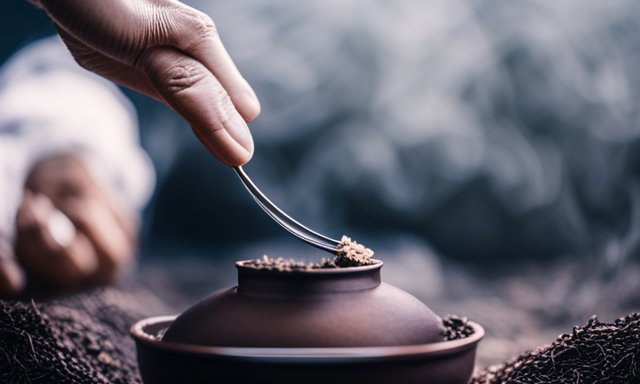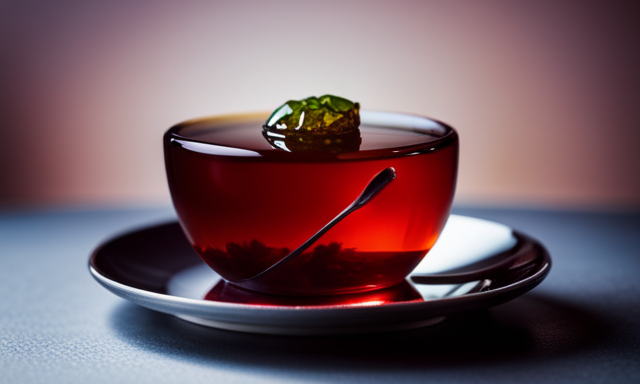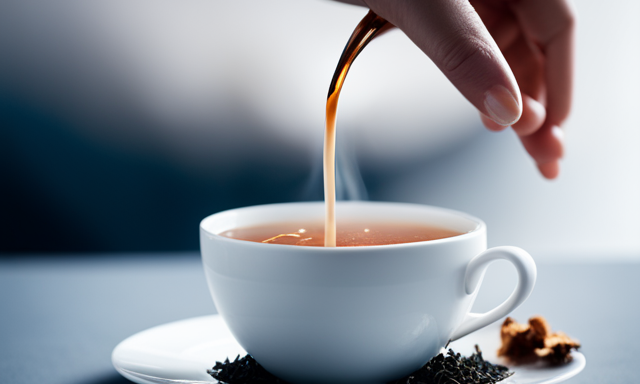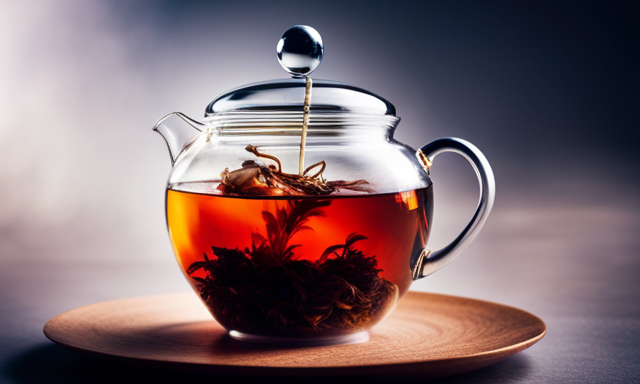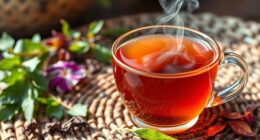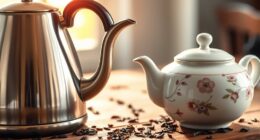Alright, folks, let’s dive into the fascinating world of oolong tea and discover how this delightful beverage is made. Have you ever wondered about the origins of oolong tea or how those tea leaves end up in your cup? Well, get ready to have all your questions answered!
In this article, I’ll take you on a journey through the intricate process of cultivating, harvesting, and processing oolong tea. We’ll explore the different stages, from withering and oxidation to fixing and rolling the leaves. We’ll also delve into the critical steps of drying, firing, and sorting the tea leaves before they’re packaged and ready for consumption.
Not only will we unravel the secrets behind the production of oolong tea, but we’ll also delve into the various varieties and the art of brewing and enjoying this exquisite beverage. Plus, I’ll fill you in on the health benefits and caffeine content that make oolong tea a popular choice for tea enthusiasts.
So, grab your favorite mug, sit back, and get ready to discover the wonders of oolong tea and how it’s made. Let’s embark on this aromatic journey together!
Key Takeaways
- Oolong tea is made from varieties such as Tie Guan Yin, Da Hong Pao, and Oriental Beauty.
- The flavors of oolong tea range from floral to toasty, influenced by oxidation and processing.
- Brewing techniques for oolong tea vary based on the type, with lighter oolongs requiring lower temperatures and shorter durations, while darker oolongs require higher temperatures and longer brewing times.
- Oolong tea offers various health benefits, including weight loss, improved heart health, and a boost in metabolism, thanks to its antioxidants, polyphenols, and minerals.
The Origins of Oolong Tea
Oolong tea, with its roots tracing back to ancient China, is a carefully crafted beverage that showcases the perfect balance between the oxidation levels of black and green tea leaves.
The history of oolong tea is rich with cultural significance, as it has been enjoyed for centuries as a symbol of tradition and refinement.
The tea leaves used to make oolong tea are plucked from the Camellia sinensis plant, and then undergo a unique process of withering, oxidation, and drying. This intricate production method requires skilled artisans who have mastered the art of oolong tea making.
By carefully controlling the oxidation levels, oolong tea achieves its distinct flavor profile and aroma.
Transitioning into the subsequent section about cultivating and harvesting the tea leaves, this meticulous process ensures that each cup of oolong tea is a true testament to the dedication and expertise of its makers.
Cultivating and Harvesting the Tea Leaves
Among the lush fields, skilled hands delicately pluck the leaves, as if gathering nature’s hidden gems. Cultivating techniques for oolong tea involve carefully selecting the right soil and climate conditions to ensure optimal growth. The tea plants are nurtured with organic fertilizers and protected from pests using natural methods. Harvesting methods are equally meticulous, with only the finest leaves being chosen for oolong tea production.
These leaves are typically harvested in the early morning when the dew is still on the leaves, ensuring maximum freshness and flavor. The leaves are hand-picked to ensure that only the best quality leaves are used. The gentle touch of the hands reveals the dedication and respect for the tea leaves. The rhythmic motion of plucking creates a sense of harmony with nature. Each leaf is a testament to the skill and expertise of the tea growers. The aroma wafting from the freshly plucked leaves evokes a sense of anticipation and delight.
As the leaves are carefully gathered, the next step in the oolong tea making process begins – withering and oxidation.
Withering and Oxidation
When it comes to making oolong tea, withering and oxidation are two crucial steps in the process. Allowing the leaves to wither helps to remove moisture from them, which enhances the flavor and aroma of the tea.
Controlling the oxidation process is equally important, as it determines the level of fermentation and ultimately the taste profile of the tea. By understanding and carefully managing these two factors, one can create a high-quality oolong tea that’s rich in flavor and complexity.
Allowing the Leaves to Wither
After being harvested, the tea leaves are carefully spread out on bamboo trays to dry, their vibrant green color slowly fading as they wither and curl under the warm rays of the sun. This crucial step, known as withering, plays a significant role in the final flavor profile of oolong tea. The withering techniques employed can greatly impact the taste and aroma of the end product. During this process, the leaves lose moisture and undergo chemical changes, resulting in the development of unique flavors and aromas. To give you a better understanding, here’s a table illustrating the different withering techniques and their impact on flavor:
| Withering Technique | Impact on Flavor |
|---|---|
| Indoor Withering | Delicate and floral |
| Outdoor Withering | Rich and earthy |
| Semi-Indoor Withering | Balanced and fruity |
By allowing the leaves to wither, we set the stage for the next step: controlling the oxidation process, which further enhances the tea’s flavor and aroma.
Controlling the Oxidation Process
To truly elevate your tea experience, you simply can’t underestimate the crucial step of controlling the oxidation process. This step is essential in determining the final flavor and aroma of the oolong tea.
Controlling oxidation involves carefully monitoring and adjusting various factors, such as temperature, humidity, and exposure to air. Tea makers employ different techniques to control oxidation, depending on the desired outcome. For example, to create a lighter oolong tea, oxidation is halted after a short period, while for a darker oolong, oxidation is allowed to progress further.
By controlling oxidation, tea makers can achieve a wide range of flavors and aromas, from floral and fruity to toasty and nutty.
As we move into the next section about fixing and rolling the leaves, we continue the transformation of the leaves into the exquisite oolong tea.
Fixing and Rolling the Leaves
First, you’ll need to fix and roll the leaves to create the perfect oolong tea. Fixing techniques involve applying heat to stop the oxidation process and preserve the tea’s flavor. There are various methods for fixing, including pan-firing and steaming.
Pan-firing involves tossing the leaves in a hot pan to remove excess moisture and halt oxidation. Steaming, on the other hand, requires exposing the leaves to steam to achieve the same effect.
After fixing, the leaves are ready for rolling. Rolling helps shape the leaves into tightly rolled balls, which enhances the tea’s flavor and aroma. Rolling can be done by hand or using machines specifically designed for this purpose. The rolling process also helps to release the tea’s natural oils, giving it a distinctive taste.
Now that the leaves have been fixed and rolled, they are ready for the next step: drying and firing.
Drying and Firing
After fixing and rolling the leaves, the next step in making oolong tea is the drying and firing process. This crucial step helps to further develop the flavors and aromas of the tea.
The leaves are carefully spread out on large bamboo trays or in drying machines and exposed to hot air. This allows the leaves to dry slowly and evenly, removing any remaining moisture.
Once the leaves are sufficiently dry, they are then fired, which involves exposing them to high heat. This firing process not only stops the oxidation of the leaves but also imparts a distinct rich flavor to the tea. The firing time and temperature can vary depending on the desired characteristics of the oolong tea.
With the leaves dried and fired to perfection, they are now ready for the next stage of the tea-making process: sorting and packaging.
Sorting and Packaging
Once the leaves have undergone the drying and firing process, they’re meticulously sorted and packaged. This ensures that each batch is carefully curated to deliver an unrivaled sensory experience.
The sorting techniques employed in oolong tea production are crucial in achieving the desired quality. Expert tea masters carefully examine and separate the leaves based on their size, shape, and color. This meticulous sorting process ensures that only the finest leaves make it into the final product, as each category contributes to the unique flavor profile of the tea.
After sorting, the tea is then packaged using high-quality materials that preserve its freshness and aroma. The packaging materials are designed to protect the delicate leaves from moisture, light, and air, ensuring that the tea reaches consumers in optimal condition.
With the leaves sorted and packaged to perfection, it’s now time to delve into the fascinating world of differentiating oolong tea varieties.
Differentiating Oolong Tea Varieties
After the oolong tea leaves have been sorted and packaged, it’s important to understand the different oolong tea varieties in order to fully appreciate the rich and diverse flavors they offer.
Oolong tea can range from light and floral to dark and roasted, with each variety having its own unique taste profile. Some popular oolong flavors include Tie Guan Yin, Da Hong Pao, and Oriental Beauty. These flavors are a result of variations in the oxidation and processing of the tea leaves.
Additionally, different brewing techniques can bring out the best flavors in each oolong variety. For example, lighter oolongs are best brewed at lower temperatures for shorter durations, while darker oolongs can handle higher temperatures and longer brewing times. Understanding these nuances will allow you to fully enjoy the complexities of oolong tea.
Moving on to the next section, let’s explore the art of brewing and enjoying oolong tea.
Brewing and Enjoying Oolong Tea
Now, let’s dive into the delightful process of brewing and savoring a cup of oolong tea. Here are the key steps to brewing the perfect cup:
-
Start by heating water to around 180°F (82°C). This temperature is ideal for oolong tea as it brings out its unique flavors.
-
Measure 1 teaspoon of oolong tea leaves per cup and place them in a teapot or infuser.
-
Pour the hot water over the tea leaves and let it steep for 3-5 minutes. This allows the flavors to infuse into the water.
-
Strain the tea leaves and pour the brewed tea into a teacup.
Oolong tea offers a wide range of tasting notes, from floral and fruity to toasty and nutty. The specific taste will depend on the variety of oolong tea you choose.
Now, let’s explore the health benefits and caffeine content of oolong tea.
Health Benefits and Caffeine Content
Let’s explore the various health benefits and caffeine content of oolong tea to understand why it can be a great addition to your daily routine. Oolong tea, with its unique blend of antioxidants, polyphenols, and minerals, offers numerous health benefits. Studies have shown that oolong tea may help with weight loss by boosting metabolism and reducing body fat. It contains caffeine, which can increase energy levels and improve mental alertness. However, oolong tea has less caffeine compared to black or green tea, making it a suitable choice for those who are sensitive to caffeine. Additionally, the polyphenols found in oolong tea have been linked to improved heart health by lowering bad cholesterol levels and reducing the risk of heart disease. Incorporating oolong tea into your daily routine can have a positive impact on your overall well-being.
| Health Benefits | Caffeine Content |
|---|---|
| Weight loss | Moderate |
| Heart health | Low |
| Antioxidants | High |
Frequently Asked Questions
How long does it take for oolong tea leaves to wither and oxidize?
The withering duration for oolong tea leaves typically ranges from 2-4 hours. After withering, the leaves are carefully oxidized for approximately 1-2 hours, resulting in the unique flavor profile of oolong tea.
What is the ideal temperature for drying and firing oolong tea leaves?
The ideal temperature for drying and firing oolong tea leaves is typically around 200-220 degrees Celsius. This process is crucial to remove moisture and halt oxidation, preserving the unique flavors and aromas of the tea leaves.
Can oolong tea be brewed using a regular tea bag?
Yes, oolong tea can be brewed using a regular tea bag. However, using a tea bag may affect the taste. Oolong tea is traditionally brewed using loose leaves to fully appreciate its complex flavors and aromas.
Does oolong tea have more or less caffeine than green tea?
Comparing oolong tea to green tea, oolong typically has less caffeine. However, it’s important to note that caffeine content can vary depending on the specific tea. In terms of taste, oolong offers a unique balance of floral and fruity notes.
What are some common health benefits associated with drinking oolong tea?
Drinking oolong tea offers various health benefits. It aids in weight loss by boosting metabolism and reducing fat absorption. Additionally, it promotes heart health by lowering cholesterol levels and reducing the risk of heart disease.
Conclusion
In conclusion, oolong tea is a true masterpiece, crafted with precision and care. It is made through a meticulous process of cultivation, harvesting, and processing. Oolong tea is a testament to the artistry of tea-making. Its distinct flavors range from floral and fruity to earthy and roasted, which captivate the senses and transport you to a world of tea bliss.
So next time you sip on a cup of oolong tea, remember the journey it took to reach your hands and savor every sip like a connoisseur.

